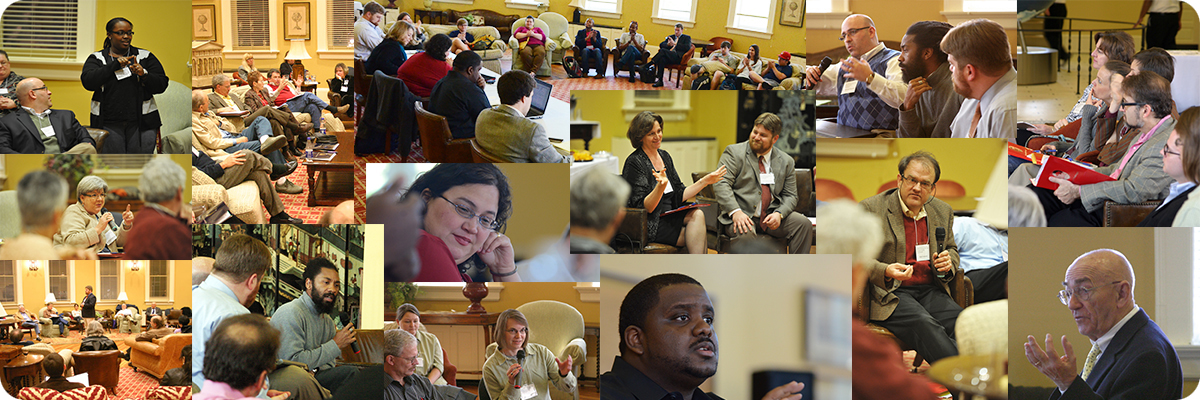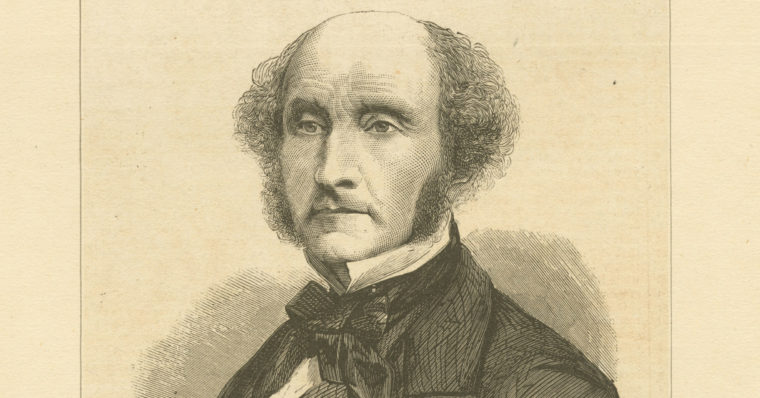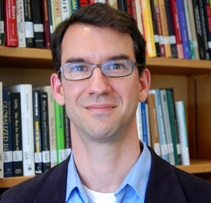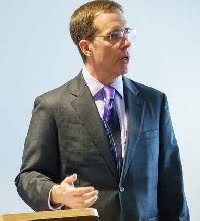| By Dale E. Miller |
I consider myself a Millian—that is, a follower of the Victorian philosopher of morals, social life, and politics (and much else besides) John Stuart Mill (1806–73). Usually I’m a fairly confident Millian; some might even say smug. Mill’s work has, like the work of all important philosophers, been subjected to numerous serious objections. But I believe that many of these objections have already been adequately answered and that the prospects of our finding satisfactory answers to the rest are at least as good as the prospects of our finding satisfactory answers to the equally serious objections that have been pressed against the work of Aristotle, Kant, etc. Still, today my confidence is beginning to show some cracks. Recent events in the U.S. are casting serious doubts on one of the most celebrated and influential elements of Mill’s thought, his defense of the freedom of expression.
Mill’s defense of the liberties of speech and the press appears in the second chapter of his 1859 essay On Liberty.[1] His case is grounded not on something like a “natural” right but rather on the social benefits of freedom of expression. This doesn’t mean that Mill believes that every use that people make of this freedom—every published article, every sign, every utterance—makes the world better off. But what he does believe is that there is great value in a vigorous marketplace of ideas, for which thoroughgoing freedom of expression is a prerequisite. According to Mill, the marketplace of ideas is a powerful engine not only for correcting intellectual errors and discovering truths of all sorts but also for motivating individuals who hold true ethical beliefs to base their lives on these beliefs. And the greater the extent to which people do this, Mill maintains (albeit without much argument), the happier that human life will be. This, for Mill, is the ultimate standard for moral rightness.[2]
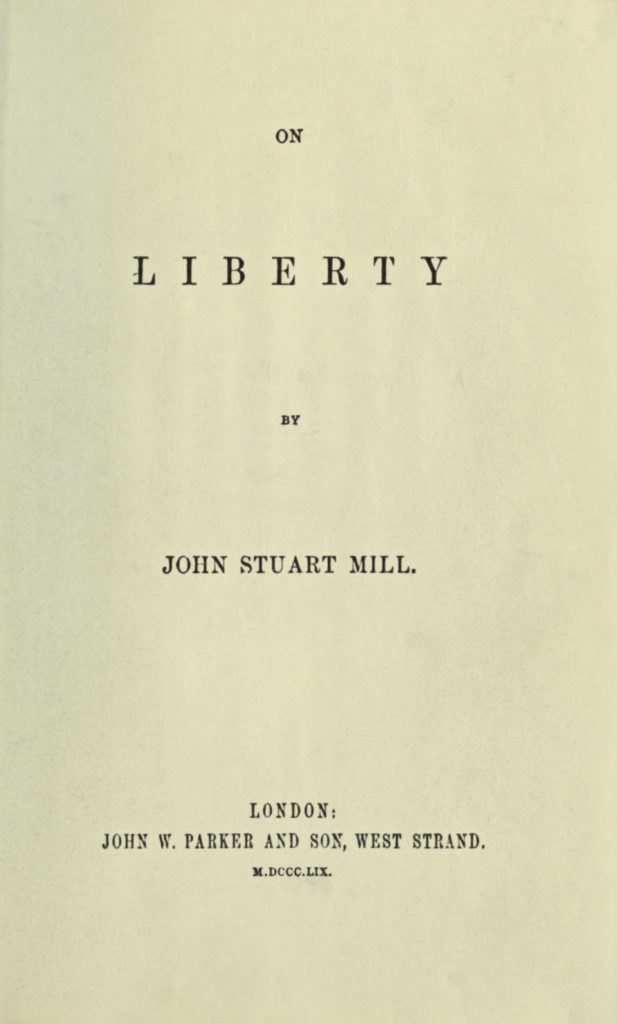
One way in which society loses when it suppresses false ideas is that when these ideas cannot receive “any fair and thorough discussion … such of them as could not stand such a discussion, though they may be prevented from spreading, do not disappear.”[3] In other words, when false ideas cannot be brought into the light and openly confronted in fair and free debate, because defending them or perhaps even discussing them is proscribed, they fester. One of the benefits that Mill therefore claims for the liberties of speech and the press is that they enable us to (eventually) extinguish false doctrines, in the sense of bringing it about that they aren’t believed.
A second way in which society loses from restricting the expression of false ideas concerns how ethical beliefs are held. Suppose that society has made it impossible to challenge some widely accepted moral doctrine, so that contrary doctrines cannot be “fully, frequently, and fearlessly discussed.” In this case, Mill says, even if the widely accepted doctrine is completely correct it will be “held as a dead dogma, not a living truth.”[4] When we know that we’re likely at some point to be called upon to defend our creed against an opponent, he writes, we’re more likely both to ensure that we understand the considerations that favor that creed and to give the creed an important place in our thoughts and actions. On the other hand, “as soon as there is no enemy in the field,” we tend to lapse into giving our beliefs little more than lip service.[5] As evidence Mill points to the many “Sunday-morning” Christians in countries in which Christianity is the dominant faith. If such Christians are animated by anything in their religion through the rest of the week, he maintains, it is only by those parts of it that are distinctive to their particular sect and that they might need to defend against other sectarians. Thus another respect in which the liberties of speech and the press are beneficial is that they make it more likely that people who hold true moral doctrines will be “penetrated” by them, in the sense of holding them as more than dead dogmas.
There is some tension between these two claims of Mill’s. After all, if false moral doctrines are extinguished, then no one will need to worry about debating their adherents. It therefore appears that freedom of expression can at most yield only one of these benefits with respect to any particular false moral doctrine, not both. The tension between these claims doesn’t rise to the level of contradiction, however. It can be true both that the long-run tendency of protecting the marketplace of ideas is to extinguish false views and that until a particular false ethical view is extinguished the fact that some people hold it will give those who hold the true view, or at least a truer one, a livelier appreciation of their own commitments. This is Mill’s stance; he observes that while it’s desirable for false moral doctrines to be extinguished, when this happens something of value is lost that society ought to try to replace to the extent possible. For instance, teachers may need to learn to defend certain false doctrines forcefully, to approximate for students the experience of debating someone who holds them.[6]
Mill’s claims about the freedom of expression license certain predictions. Suppose that some false moral doctrine was introduced into a society a considerable time ago. Suppose further that in this society it has always been possible to discuss and debate this doctrine freely. Then Mill’s claim would seem to suggest, first, that over time we should expect this doctrine to have moved some significant distance in the direction of being extinguished, and, second, that if this doctrine does still persist to some degree then people whose views about the matter in question contain more of the truth will be more strongly motivated to think, feel, and act in conformity with those views. Mill’s claims thus serve as a comforting answer to the question of whether it is safe to extend the freedom of expression to wrongheaded or even evil extremists, as American First Amendment jurisprudence does: the “invisible hand” of the marketplace of ideas will move them toward eradication, and until it gets them there, they will actually contribute to the moral improvement of the majority.
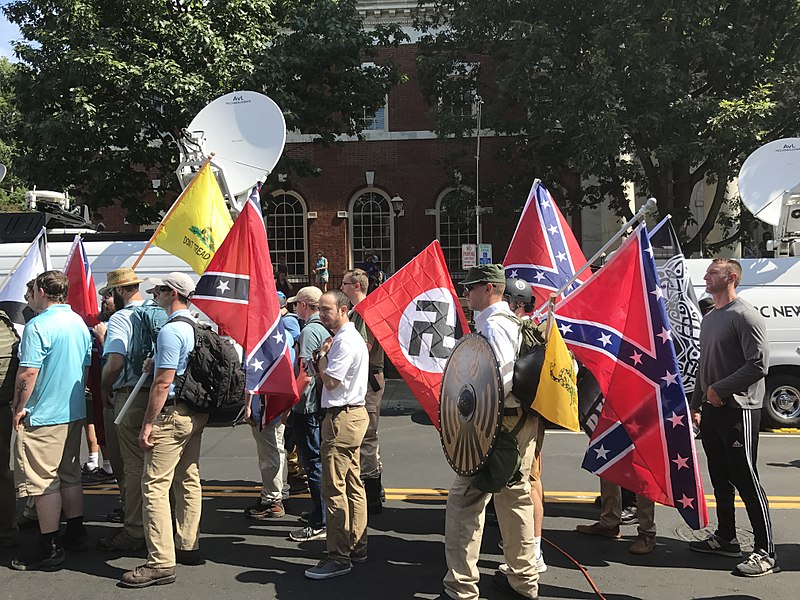
Photo by Anthony Crider, 2017, CCO license.
But are these predictions borne out by recent political experience? Consider one particular false moral doctrine, namely white supremacy. While broader definitions are possible, I’m using ‘white supremacy’ to refer to the ideologies that we associate with groups such as the Nazis and the Ku Klux Klan, ideologies marked by features like Holocaust denialism, enthusiasm for William Pierce’s The Turner Diaries, and support for laws that explicitly deny basic rights to non-whites and/or Jews. (I won’t entertain the notion that this doctrine might not be false.)
White supremacy so understood has a long history in the U.S., and the First Amendment protects the freedom of white supremacists to promote their views in public. At first glance, it seems that if Mill is right then the doctrine of white supremacy should be well on its way to being extinguished here. Failing this, it appears that we should at least expect that Americans who reject that doctrine should not only have a solid grasp of their grounds for doing so but should also be more strongly committed to racial equality. In other words, white Americans who aren’t supremacists should be disinclined to treat phrases like “all men are created equal” as empty pieties—dead dogmas.
Were Mill alive today, it would be hard not to ask him “How’s that working out for you?” White supremacists in America today clearly believe that they have a fellow traveler in the White House (and if they are wrong then President Trump has hardly labored to disabuse them of the notion). With this “high cover” they are bolder and more brazen than they have been in decades, and it is apparent now that they are more numerous than most Americans expected. Any consoling fantasies that we might have had about how their positions were moving toward being extinguished have been punctured. Moreover, there is little evidence that white Americans who reject white supremacy as I have defined it—and I believe that this is still the great majority, even among Trump voters—have the lively appreciation of racial equality that Mill’s claims seem to suggest that they should. The ample body of evidence for the contrary conclusion includes a July 2017 poll showing that 65% of white respondents had an unfavorable view of the Black Lives Matter protests and protestors[7] and a recent meta-analysis conforming that discrimination in hiring against African-Americans exists (and isn’t becoming any less common).[8]
Given this, it’s no wonder that doubts are being raised about whether we can safely trust the marketplace of ideas where extremist views are concerned. In an editorial defending student protesters who “shout down” talks on college campuses by speakers with racist views, David Shih argues that “The ‘marketplace of ideas’ fails when we cannot make objective choices about racism.”[9] He maintains that racism is so pervasive in the world view of (at least) Americans that they frequently fail to recognize it as such, with the result that they cannot be relied upon to “reliably reject a shoddy product — here, the snake oil of racist expression.” And if they do not, this “might mean that racist hate speech is not a ‘necessary evil’ that jumpstarts racial justice within a liberal marketplace but is—for the foreseeable future—nothing more than state-sanctioned injury of people of color.”[10]
While Shih doesn’t mention Mill, his criticisms of the metaphor of the marketplace of ideas are directly applicable to Mill’s defense of free speech. I’m far from dismissing these criticisms; it’s precisely because of points like those that Shih raises that, as a Millian, I’m increasingly nervous. But it’s worth considering what can be said on Mill’s behalf.
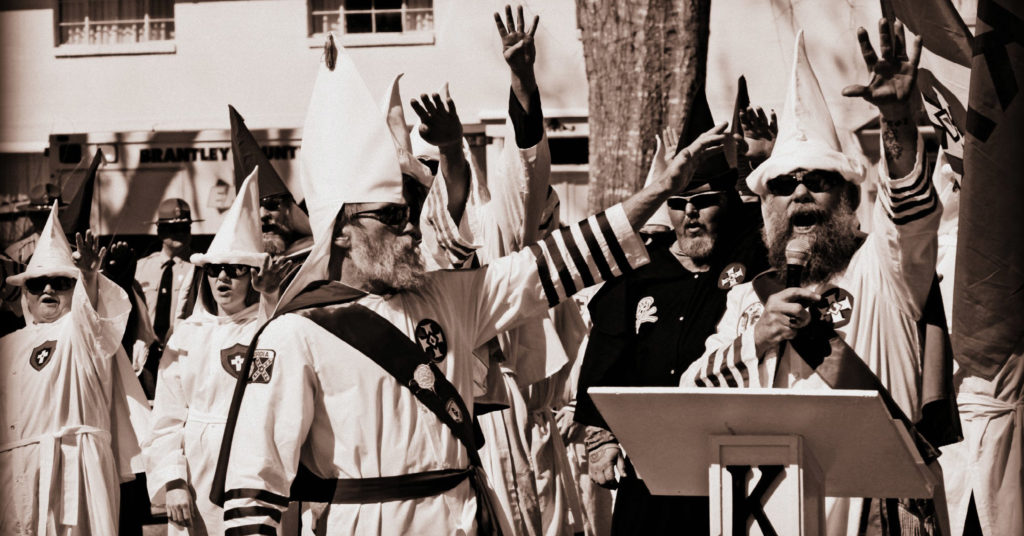
Photo by Craig O’Neal, 2006, CCO license.
One possible reply is that people are so prone to racist thinking, for whatever reasons, that the fact that white supremacy has not moved any closer to being extinguished is not surprising and does not undermine Mill’s claim that false moral doctrines tend to move in this direction where the freedom of expression prevails. Given that the bias is widespread and deep-seated—one might say insidious—and for that reason easily unnoticed and so not reckoned with, we should expect progress in this area to be at best slow and incremental, with occasional backsliding. To this one might add that while it has been legally permissible for white supremacists to openly express their views in the United States, it has for some time not been socially acceptable. Even in the absence of active interference with their communication, the social disapprobation that people publicly identified as white supremacists would suffer largely forced them to restrict the expression of their views to clandestine newsletters or, more recently, dark anonymous corners of the Internet. Perhaps it’s only now that more of them feel able to emerge from hiding that we can have the fair and free debate regarding their views that Mill takes to be capable of convincing people to recognize and reject false moral doctrines. A recent editorial in the Washington Post optimistically proposes that
There is no surer way to expose extremism’s malice and toxicity than to let it bask in the sunlight, where all Americans can examine it plainly. The more Mr. [Richard] Spencer spouts his gospel of hatred—he advocates “peaceful ethnic cleansing,” by which he means Jews and nonwhites should have no place in the United States and should be induced to leave—the more his countrymen will be repelled.[11]
A second reply is that suppressing the expression of white supremacy hasn’t proven to be efficacious as a way of preventing people from subscribing to it. Throughout much of Europe, hate speech laws significantly restrict the ability of white supremacists to disseminate their views. As Erik Bleich writes, “In most European countries, it is against the law to assert in public that a racial, ethnic or religious group is to be feared or hated, and in many countries illegal to say that the Holocaust never happened.”[12] Yet Europe’s problems with the racist “ultra-right” are arguably just as grave as those of the United States. For instance, despite Germany’s restrictions on white supremacists’ freedom of expression, including bans on the use of Nazi-era slogans and symbols, the country’s most recent annual report on its constitution documents increasing numbers of “violent offences motivated by right-wing extremism.”[13] A right-wing anti-immigration party, some of whose leaders have a penchant for Nazi-era language, just won nearly 13% of the vote in the German national election.[14] Large neo-Nazi demonstrations, with more arcane symbols, are occurring there as well.[15] Admittedly, the degree to which the freedom of expression is regulated is not the only relevant difference between the United States and Europe; that a far-right party could garner seats in the Bundestag with 13% of the vote points to pertinent differences in electoral systems. Thus care is needed in trying to draw any inferences about the effectiveness of these regulations from cross-cultural comparisons of the currency of white supremacist views. Still, it’s at least not obvious that they are any more successful than a reliance on the marketplace of ideas in preventing the contagion of white supremacy from spreading.
Finally, if this stage of history is one when we must take seriously the threat of white supremacists and fascists more generally, then this may be precisely the worst time for us to weaken the legal and social protections afforded to the freedom of expression. Once we decide that it’s acceptable for the proponents of unpopular views to be silenced, whether by law or the heckler’s veto, then the precedent this creates will make it easier for the opponents of equality to justify silencing progressives and liberals if they can. If we want such an event to trigger popular outrage in the future, to be seen as crossing uncrossable lines, then we may need to do all that we can now to entrench the inviolability of the liberties of speech and the press. (Shih dismisses this worry, asserting that the students he defends “may not, in fact, long for their First Amendment rights should the tables turn on them.” His reasoning seems to be that in the past progressive protesters have been most effective when they’ve gone beyond what the First Amendment protects anyway. But this complicates his larger argument; if expressive activity is most persuasive when it takes forms that exceed First Amendment protections, then denying these protections to racist speech might increase its influence.)
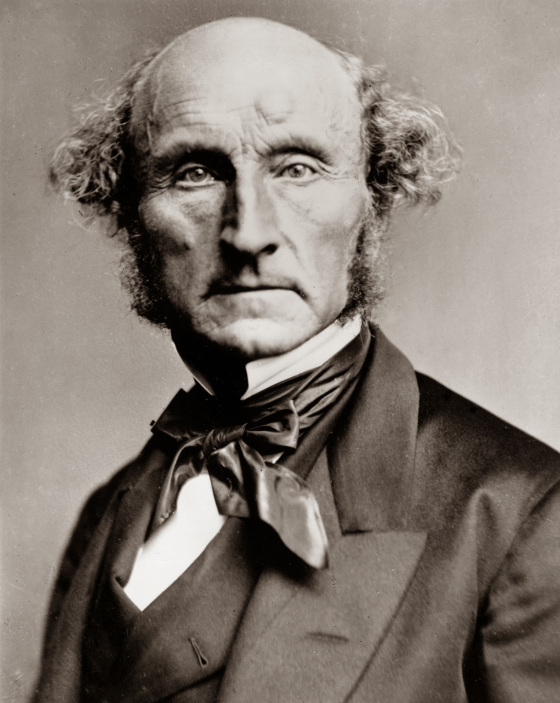
But if relying upon the marketplace of ideas is a gamble, so too is abandoning the First Amendment jurisprudence and social norms that protect even the speech and writings of white supremacists against interference. No safe option exists. While I’m increasingly nervous that Mill might be wrong, I’m no less nervous that he might be correct and yet go unheeded when it matters most, that we might panic in the face of a tiki-torch-bearing rabble and abandon one of our most potent weapons against them.[17]
Dale Miller is a Professor of Philosophy at Old Dominion University in Norfolk VA. Much of his work has focused on John Stuart Mill’s moral and social-political philosophy. His book J. S. Mill: Moral, Social and Political Thought was published by Polity in 2010. He has also co-edited A Companion to Mill (Wiley-Blackwell, 2017), The Cambridge Companion to Utilitarianism (Cambridge, 2014), John Stuart Mill and the Art of Life (Oxford, 2011), and Morality, Rules, and Consequences: A Critical Reader (Edinburgh, 2000). In the summer of 2016, Professor Miller became the editor-in-chief of Utilitas.
Notes
[1] Mill, On Liberty, Collected Works of John Stuart Mill v.18, ed. J. M. Robson (Toronto: University of Toronto Press, 1977), 228–59. PDFs of Mill’s Collected Works are available for free in Liberty Fund’s Online Library of Liberty: http://oll.libertyfund.org/people/john-stuart-mill.
[2] For an explanation of how and why this is true, and a wide-ranging account of Mill’s “value theory,” see my John Stuart Mill: Moral, Social and Political Thought (Cambridge: Polity 2010).
[3] Mill, On Liberty, 242.
[4] Mill, On Liberty, 243.
[5] Mill, On Liberty, 250.
[6] Mill, On Liberty, 250–1.
[7] “July 2017 Poll: Crosstabs Memo,” HarvardHarrisPoll.com, available at http://harvardharrispoll.com/wp-content/uploads/2017/07/Crosstabs-HCAPS_July-Wave_Topline-Memo_Registered-Voters_Custom-Banners….pdf.
[8] Lincoln Quinlan, Devah Pager, Ole Hexel, and Arnfinn H. Midtbøen, “Meta-Analysis of Field Experiments Shows No Change in Racial Discrimination in Hiring Over Time,” Proceedings of the National Academy of Sciences of the United States of America, published early online at http://www.pnas.org/content/early/2017/09/11/1706255114.full.
[9] Shih, “Hate Speech and the Misnomer of ‘The Marketplace of Ideas,’” Code Switch: National Public Radio (3 May 2017), available at http://www.npr.org/sections/codeswitch/2017/05/03/483264173/hate-speech-and-the-misnomer-of-the-marketplace-of-ideas.
[10] Shih’s suggestion that racist speech injures people of color raises important issues that I can’t consider here, but if it is true that racist speech damages the interests of its targets then even Mill might concede that this speech should be restricted, the virtues of the marketplace of ideas notwithstanding.
[11] Editorial Board, “Let the White Nationalists March—and Their Ideas Die,” The Washington Post (12 October 2017), available at https://www.washingtonpost.com/opinions/let-white-nationalists-march–and-their-ideas-die/2017/10/12/6dbbded0-adef-11e7-9e58-e6288544af98_story.html?undefined&utm_term=.ca4369164292&wpisrc=nl_headlines&wpmm=1.
[12] Bleich, “Freedom of Expression versus Ethnic Hate Speech: Explaining Differences Between High Court Regulations in the USA and Europe,” Journal of Ethnic and Migration Studies 40 (2014), 297.
[13] Federal Ministry of the Interior, “Brief summary: 2016 Report on the Protection of the Constitution” (4 July 2017), available at https://www.verfassungsschutz.de/en/public-relations/publications/annual-reports.
[14] See Anthony Faiola and Stephanie Kirchner, “In Germany, the Language of Nazism is no Longer Buried in the Past,” Washington Post 9 December 2016), available at https://www.washingtonpost.com/world/europe/in-germany-the-language-of-nazism-is-no-longer-buried-in-the-past/2016/12/09/d70bce74-bc85-11e6-ae79-bec72d34f8c9_story.html.
[15] Bethany Allen-Ebrahimian, “What Happens When You Ban Nazi Symbols at a Nazi March?,” Foreign Policy (21 August 2017), available at http://foreignpolicy.com/2017/08/21/what-happens-when-you-ban-nazi-symbols-at-a-nazi-march/.
[16] A related cause for concern, which I can’t consider here, is whether the marketplace of ideas is vulnerable to a flood of shoddy counterfeit “goods” from abroad—say, from Russia. This too may largely depend on how well we’ve trained citizens to think critically.
[17] I would like to thank Andrew J. Cohen for a number of helpful comments.
